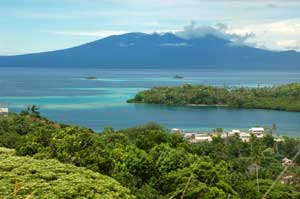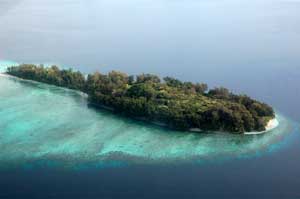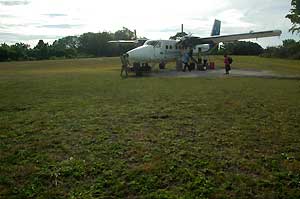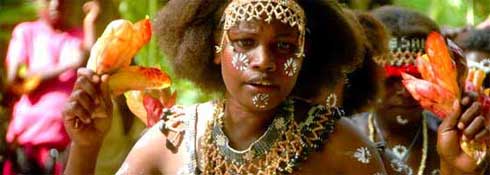Solomon Islands
Background
The Solomon Islands is not only a country of breathtaking natural beauty, it is also a land of people who practise a variety of exotic cultures. It truly is the Pacific's melting pot, where descendants of Oceania's three main cultural groups of Melanesia, Polynesia and Micronesia merge and cohabit as one nation, proud of their rich and unique cultural identity.
 Located in the southwest Pacific, 2,000 km (1,200 miles) northeast of Australia and 2,400 km (1,500 miles) west of Fiji, The Solomon Islands is made up of nearly one thousand stunning, tropical islands covering a land mass of 28,400 square kilometres (10,965 sq mi). The capital, Honiara, is located on the island of Guadalcanal, famed as the scene of a major battle during the second world war and subsequently a big draw to wreck-seeking scuba divers.
Located in the southwest Pacific, 2,000 km (1,200 miles) northeast of Australia and 2,400 km (1,500 miles) west of Fiji, The Solomon Islands is made up of nearly one thousand stunning, tropical islands covering a land mass of 28,400 square kilometres (10,965 sq mi). The capital, Honiara, is located on the island of Guadalcanal, famed as the scene of a major battle during the second world war and subsequently a big draw to wreck-seeking scuba divers.
 The Solomon Islands is a Maldives waiting to happen! Stunning tropical forest clothes the islands that are fringed with white sand beaches and rich coral reefs, set in pristine, turquoise seas. Presently the islands receive less than 10,000 tourist each year making it an adventurer's paradise.
The Solomon Islands is a Maldives waiting to happen! Stunning tropical forest clothes the islands that are fringed with white sand beaches and rich coral reefs, set in pristine, turquoise seas. Presently the islands receive less than 10,000 tourist each year making it an adventurer's paradise.
 Air access to the Solomon Islands is via Nadi, Fiji; Brisbane, Australia or Port Moresby in Papua New Guinea. Transport around the islands is by boat and small plane.
Air access to the Solomon Islands is via Nadi, Fiji; Brisbane, Australia or Port Moresby in Papua New Guinea. Transport around the islands is by boat and small plane.
Alvaro de Mendana, the Spanish explorer who discovered the islands, marvelled at the wonders these islands had to offer and named it the Solomon Islands in reference to the wealth of the biblical King Solomon. Today, the Breathtaking tropical beauty, the strikingly unique flora & fauna, alongside the ethnic diversity of exotic cultures still practiced by its people remain excellent reasons to visit.

Among its many treasures, the Solomon Islands boasts the world's largest salt water lagoon in Morovo, and the world's second largest atoll in Ontong Java. The crystal clear waters are perfect all the year round making it a snorkelling and diving paradise.
History
The Solomon Islands are believed to have been inhabited by Melanesian people for thousands of years. In the 1890s the United Kingdom established a protectorate over the Islands bringing them into the realm of the British Empire. They finally attained self-government in 1976 and independence two years later.
During World War II, some of the most bitter fighting occurred in the Solomon Islands campaign of 1942–45, including the infamous Battle of Guadalcanal.
Nowadays the Solomon Islands is a constitutional monarchy and remains a member of the British Commonwealth, retaining Queen Elizabeth II as the head of state. Since 1998, ethnic violence, government misconduct and crime have undermined stability and society, and in June 2003 an Australian-led multinational force, the Regional Assistance Mission to the Solomon Islands (RAMSI), arrived to restore peace, disarm ethnic militias and improve civil governance.
It is believed that Papuan speaking settlers began to arrive around 30,000 BC. Austronesian speakers arrived circa 4,000 BC also bringing cultural elements such as the outrigger canoe. It was between 1,200 and 800 BC that the ancestors of the Polynesians, the Lapita people, arrived from the Bismarck Archipelago with their characteristic ceramics. The first European to discover the islands was the Spanish navigator Álvaro de Mendaña de Neira, sailing from Peru in 1568.
Missionaries began visiting the Solomons in the mid-19th century. They made little progress at first, because "blackbirding" - the often brutal recruitment of labourers for the sugar plantations in Queensland and Fiji - led to a series of reprisals and massacres. The evils of the labour trade prompted the United Kingdom to declare a protectorate over the southern Solomons in 1893. This was the basis of the British Solomon Islands Protectorate.
In 1898 and 1899, more outlying islands were added to the protectorate; in 1900 the remainder of the archipelago, an area previously under German jurisdiction, was transferred to British administration, with the exception of the islands of Buka and Bougainville which remained under German administration as part of German New Guinea until they were occupied by Australia in 1914, after the commencement of World War I.
Traditional trade and social intercourse between the western Solomon Islands of Mono and Alu (the Shortlands) and the traditional societies in the south of Bougainville, however, continued without hindrance. Under the protectorate, missionaries settled in the Solomons, converting most of the population to Christianity. In the early 20th century, several British and Australian firms began large-scale coconut planting. Economic growth has been slow, however, and the islanders have benefited little.
Controlled, responsible tourism could become a major benefit to the islanders.
Highlights
The Solomon Islands is an archipelago of almost 1,000 tropical islands, clothed in rainforest and ringed by white sand beaches. It is located to the east of Papua New Guinea and Australia's Queensland, and west ot Fiji.
The Solomon Islands offer a fascinating mix of ethnic groups, unique wildlife, undeveloped beaches and unspoiled coral reefs.




